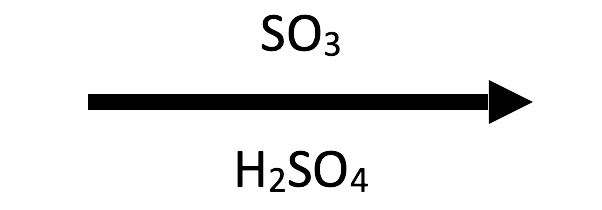Aromatic Reactions: Sulfonation using SO3/H2SO4
Aromatic Reactions: Sulfonation using SO₃/H₂SO₄
Fuming sulfuric acid (oleum) is literally sulfuric acid saturated with sulfur trioxide—excess SO₃ escapes as white fumes whenever the liquid meets air. That dissolved SO₃ (or its protonated form HSO₃⁺ in wetter acid) is the active sulfonating electrophile. The resulting SO₃/HSO₃⁺ reacts with aromatic π bonds through the classic electrophilic aromatic substitution (EAS) sequence: π attack forms a σ-complex, then deprotonation restores aromaticity and delivers Ar–SO₃H. The process is reversible—heating the sulfonic acid in hot dilute acid/steam removes –SO₃H (desulfonation). Regiochemistry follows the directing rules: electron-donating groups (EDG) give ortho/para, electron-withdrawing groups (EWG) give meta, and halogens are the exception (deactivating yet ortho/para-directing). Because –SO₃H is strongly deactivating/meta-directing, it serves as a temporary blocking group for multistep EAS sequences.
Key Emphasis (Teaching Pivots)
- Electrophile generation: Concentrated H₂SO₄ establishes SO₃ (dehydration) and/or HSO₃⁺. Either form serves as the sulfonating electrophile.
- EAS sequence: π attack → σ-complex (arenium ion) → deprotonation. Closed-shell ionic pathway—no radicals.
- Reversibility: Hot dilute H₂SO₄ (steam) removes –SO₃H. Use sulfonation/desulfonation to block para or ortho positions temporarily.
- Directing logic: Substitute orientation derives from EDG vs EWG. EDG → ortho/para (para favored when ortho is crowded). EWG → meta. Halogens are deactivating but still ortho/para.
- Blocking-group warning: Once installed, –SO₃H is strongly deactivating and meta-directing for subsequent EAS.
Quick Summary
- Reagents/conditions: SO₃ dissolved in concentrated H₂SO₄ (oleum/fuming H₂SO₄). Typical temperatures: 0–80 °C; desulfonation uses hot dilute acid or steam (~100 °C).
- Electrophile: SO₃ ⇌ HSO₃⁺ (depending on water content). Draw whichever makes the story clearest.
- Mechanism: π attack at sulfur → σ-complex → base removes the benzylic proton → Ar–SO₃H.
- Regiochemistry: EDG accelerate and direct ortho/para. Strong deactivators (–NO₂, –CF₃, –SO₃H) give meta. Halogens are deactivating but ortho/para-directing.
- Reversibility: Desulfonation under hot dilute H₂SO₄ liberates the arene; treat –SO₃H as a temporary blocking group.
- Use cases: Install sulfonic acids (p-toluenesulfonic acid, etc.) or protect positions for later nitration/halogenation/Friedel–Crafts sequences.
Mechanism — SO₃/H₂SO₄ Sulfonation (4 Frames; arrows A–H)
Worked Examples
Benzene → benzenesulfonic acid

Unsubstituted benzene gives benzenesulfonic acid; heating with dilute acid reverses the process (desulfonation).
Toluene (EDG) → p-toluenesulfonic acid (major)

Alkyl groups activate and direct ortho/para; para dominates because the ortho site is congested, but both products form. Reversible sulfonation/desulfonation lets you bias toward the para product.
Nitrobenzene (EWG) → m-nitrobenzenesulfonic acid

Strong –M/–I substituents (–NO₂, –CF₃, –C=O, –SO₃H) deactivate the ring and direct meta. Expect harsher conditions and lower rates.
Anisole (strong EDG) → p-methoxybenzenesulfonic acid (major)

Strong EDG (–OR, –NR₂) make sulfonation very fast; both ortho and para products appear with para favored if sterics or blocking strategies (sulfonate/desulfonate cycling) are used.
Scope & Limitations
- Activated rings (–OH, –NR₂, –OR, alkyl) react rapidly at ortho/para. Control temperature to avoid polysulfonation.
- Halobenzenes are deactivating yet still give ortho/para sulfonation; para often preferred because ortho is sterically hindered.
- Strongly deactivated rings (–NO₂, –SO₃H, –CF₃, –C=O) are meta-directing and require higher temperatures or longer reaction times.
- Blocking strategy: –SO₃H is meta-directing and removable; use it to “protect” a position during nitration or Friedel–Crafts sequences.
- Functional group tolerance: Harshly acidic/oxidizing medium—protect acid-sensitive groups and handle reagents with appropriate PPE.
Practical Tips & Pitfalls
- Forward sulfonation: Use fuming H₂SO₄ (oleum). Control temperature to limit polysubstitution; quench cautiously (strongly exothermic).
- Desulfonation: Heat the sulfonic acid in dilute aqueous H₂SO₄ or steam (~100 °C). This equilibrates back to Ar–H.
- Blocking-group workflow: Install –SO₃H, perform another EAS (e.g., nitration para to an –OH), then desulfonate. Para enrichment improves with repeated sulfonation/desulfonation cycles.
- Safety: SO₃/H₂SO₄ are highly corrosive and generate choking fumes. Use a hood, acid-resistant gloves, face shield, and have an ice bath ready for additions.
Exam-Style Summary
SO₃/H₂SO₄ (oleum) installs –SO₃H on aromatic rings via an electrophilic aromatic substitution: generate SO₃/HSO₃⁺, attack to form the σ-complex, then deprotonate to restore aromaticity. The reaction is reversible in hot dilute acid (desulfonation). Apply directing rules—EDG give ortho/para, strong EWG give meta, halogens are special (deactivating yet ortho/para). Remember: –SO₃H is strongly meta-directing if left on the ring.
Interactive Toolbox
- Mechanism Solver — Use Mechanism Solver to see each step of the SO₃/H₂SO₄ sulfonation mechanism with narrated explanations.
- Reaction Solver — Use Reaction Solver to predict ortho/meta/para outcomes for substituted arenes and try blocking-group plans.
- IUPAC Namer — Use IUPAC Namer to practice naming aryl sulfonic acids and the desulfonated follow-up products.
Global Directing-Effects Reference (EDG/EWG)
| Category | Representative groups | Notes |
|---|---|---|
| Strong ortho/para directors (activating) | –NH₂, –NHR, –NR₂, –OH | Lone-pair resonance donation dominates; fastest EAS. |
| Moderate ortho/para directors (activating) | –OR, –NHCOR, –OCOR, alkyl (–R), aryl (–Ar) | Donate via resonance or hyperconjugation; para often favored sterically. |
| Halogens (deactivating yet ortho/para) | –F, –Cl, –Br, –I | –I > +M, so rate is slower but orientation remains ortho/para. |
| Meta directors (moderately deactivating) | –CHO, –COR, –CO₂H, –CO₂R, –CONH₂/–CONR₂, –CN, –SO₂R, –SO₃H | Withdraw by –M/–I; meta substitution avoids high-energy σ-complex resonance forms. |
| Strong meta directors (strongly deactivating) | –NO₂, –CF₃/–CCl₃, –NR₃⁺, –SO₂CF₃ | Markedly slow EAS; require forcing conditions. |
Heuristics: Lone-pair donors (attached directly to the ring) activate and direct ortho/para. Groups that feature a positively charged or strongly withdrawing atom at the ring juncture direct meta. Halogens are the sole “deactivating yet ortho/para” class.